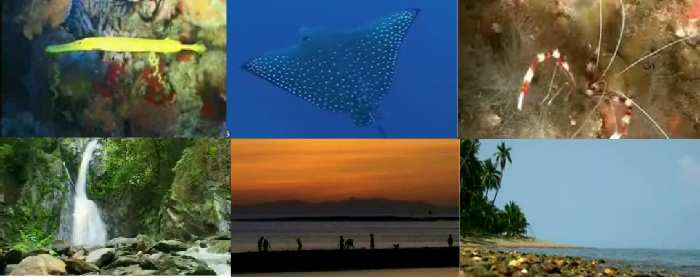Sibuyan is a crescent-shaped island of Romblon Province, Philippines. It has an area
of 445 sq km. Primary forests cover 140 sq km, or 33% of the land area of Sibuyan.
owever, most of the lower altitude forest has been logged or is secondary. Mt Guiting-guiting
Natural Park (equivalent to the IUCN category of National Park) was established to
protect these forests, which are mainly in the centre and north of the island, and
covers an area of about 157 sq km out of Sibuyan’s total area of 445 sq km. The Park
is remarkable for its outstandingly scenic landscape with twin towering peaks set
amidst closed canopy forests. Its forests remain largely intact, and include the
entire elevational gradient from lowland dipterocarp forest (at 200-900 m) and mangroves,
through montane forest (above 700 m) to mossy forest, heathland and montane grassland
around the peaks. The whole island is likewise proclaimed as an initial component
as protected area as a mangrove forest swamp reserve.
The island has lived with its isolation from the rest of the world since its birth.
Never in its geological history has it ever been connected with any part of the Philippine
archipelago. Seismic forces pushed up a 2,000-meter peak from the earth’s crust,
forming a series of smaller peaks and slopes. The peak is Mt. Guiting-guiting (literally
means "the saw-toothed mountain", in reference to its jagged ridge. And because of
the steep slopes, much of its original forest remains untouched), and the rest is
the island as we find it today.
Known for its biodiversity, Sibuyan has been dubbed by local and international natural
scientists as the Galapagos of Asia. Its significance to the world’s animal and plant
diversity cannot be taken lightly—one of the richest spots in the world in terms
of density, diversity and endemism of flora and fauna.
Exact figures of plant species are hard to give, as biologists continue to stumble
upon species yet unidentified by the scientific community. In one study, the National
Museum identified 1,551 trees in a single hectare, with 123 species of trees. Of
this number, 54 are found nowhere else in the world. Sibuyan’s forest has been proclaimed
as the world’s densest forest.
There are estimated to be 700 vascular plant species on the island.
There are 131 species of birds that share the skies with ten species of fruit bats,
and the plethora of land-dwelling mammals, reptiles, and rodents have yet to be fully
catalogued. It is likely that several of these birds will prove to have important
populations in the extensive forests of Mt Guiting-guiting National Park. Three subspecies
are endemic to Sibuyan, Colasisi Loriculus philippensis bournsi, Philippine Pygmy-woodpecker
(Dendrocopos maculatus ménagei) and Orange-bellied Flowerpecker (Dicaeum trigonostigma
sibuyanicum), all of which were recorded there in the early 1990s, and two more to
Sibuyan and other nearby islands. Five species of mammals (all threatened) (one fruit
bat and four rodents) are endemic to Sibuyan, and the critically endangered fruit
bat Nyctimene rabori occurs there.
Scientists have yet to fully catalog the land-dwelling mammals, reptiles, and rodents
that can be found in the island.
Background Music "Nice Sibuyan" composed by Tom Hero








